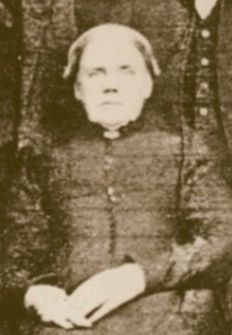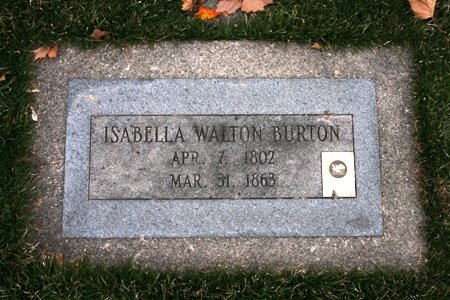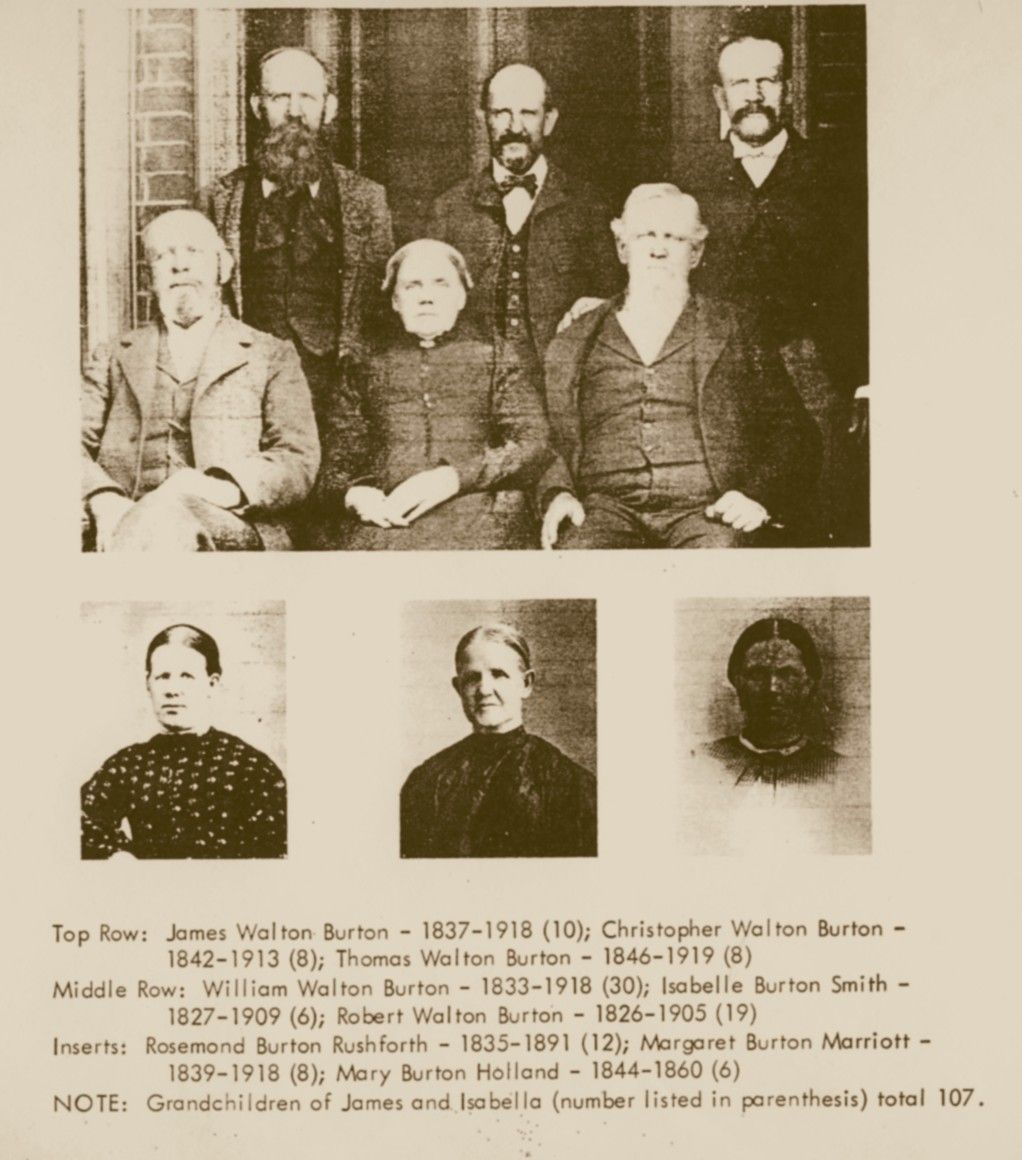Married James Burton, 5 Mar 1825, Hawes, Yorkshire, England. He died 18 Jul 1849. Manningham, Bradford, Yorkshire, England.
Children - Robert Walton Burton, Isabella Burton, James Walton Burton, William Walton Burton, Rose Mary Burton, Rosemond Burton, James Walton Burton, Margaret Burton, Ann Burton, Christopher Walton Burton, Mary Burton, Thomas Walton Burton
History: Isabella Walton was born 7 Apr 1802. The Quaker records gave Buttersett of Hawes as the place of her birth, but her Patriarchial Blessing lists Dent, Yorkshire, England. They were Quakers. They were probably able financially to give their two children some educational opportunities. Isabella's brother, four years her senior, was head booker of a large firm operating coal mines in the vicinity of town Bishop Auckland in England. He had an income of 400 pounds sterling.
Isabella married James Burton in March of 1825 and later moved to Bradford, England. There they heard the missionaries and were baptized. Their children were baptized later. James her husband died in 1849, leaving nine children for Isabella to care for, her youngest only 2 years old. Her oldest son Robert had emigrated to Utah some time before with his Uncle Robert. So 16 year old William had to help all he could with supporting the family. About two years later, the president of the mission asked Isabella if she was willing for William to go on a mission. He stated that he had been impressed to call upon young William to go and preach the gospel. Her eyes filled with tears, realizing that it would deprive her of her son's much needed help but her answer was positive. "If the Lord wants him, I am willing for him to go." When the appointed time came for him to start on his mission, from the little money he had saved, he purchased a dress for him mother, and an entire suit of clothes for himself. The remainder of the money he left at home, as the elders were required to preach the gospel without purse or script.
We do not have a complete record of how she met her problems while William was gone. Her daughters Isabella and Rose got work in the factory weaving cloth. They had to be at work at 6 o'clock in the morning and had to walk 3 miles there and 3 miles back, after having stood at their looms all day. Margaret, the next daughter, had to do all she could to help her mother.
One of Isabella Walton's outstanding skills was knitting. She used a sheath or shield in which to hold her knitting needles, and worked so rapidly that her needles could not be seen, only the clicking of the needles could be heard. In an evening she could make a pair of socks.
After William returned from his mission they decided it was best for him to go to America, find his brother Robert, and the two of them prepare a home and send for their mother and their brothers and sisters. William went on to Utah and met his brother Robert, and together they were able to send for their mother and family.
The family sailed for America on the 22nd of April 1866, on Ship Samuel Curling. They were listed on the ship's records as follows:
Isabella Burton, age 52
Isabella Burton, age 22
Rosemond Burton, age 19
James Burton, age 17
Margaret Burton, age 15
Christopher Burton, age 12
Mary Burton, age 10
Thomas Burton, age 8
They arrived in New York the 22nd of May, 1855, where they traveled by train to St. Louis and then on to Kansas. Isabella and her seven children crossed the plains in the 8th Company of Captain Milo Andrus and arrived in Salt Lake City the 24th of October in 1855. "Andrus was not a very kind man.---It was hard for Isabella to walk so much, so sometimes she stole a ride to help her along. One day as she was climbing in a wagon when Isabella fell from the wagon. The wheel passed over her leg and broke the bone. It was set and bandaged and doctored by plasters of cow manure.
They walked about 20 miles a day, crossed many rivers on foot and would be very weary at night. When they camped at night after eating their scanty meal, they would have prayers and sing. "Why should we mourn or think our lot is hard, tis not so, all is well." Food was scarce; their flour was weighed out to them, and many times they had very little to eat.
At Fort Bridger they were met by their two oldest sons, Robert Walton Burton and William Walton Burton with provisions. They arrived in Salt Lake City on October 24, 1855. They for a while stayed at Robert's home located on what is now know as the Greener Farm. They latter settled in Kaysville, Utah,
The winter of 1855 was known as the "hard winter'. They had very little food. For six weeks they did not taste bread. What little wheat flour they used for thickening soup, which was made from an old cow that was so thin it couldn't stand up, so the cow was killed and the meat used for soup. In the spring of that year, their food consisted mainly of greens, being made from nettles or other kinds of weeds.
Isabella Walton Burton was given a Patriarchial Blessing by Issac Morley in Kaysville, Utah on September 7th, 1857. It states that she was the daughter of William and Isabella Walton and was born at Dent, Yorkshire, England. She was promised that her children would bless and honor her, that she should have peace of mind. That she would enjoy health and her last days would be her best days. Because of her integrity, she was beloved by the Lord.
The latter part of her life she lived in Kaysville with William and Rachel Burton. They had been away from home and upon returning asked her how she was feeling. She said "Oh, I feel so fine I could jump over the moon." But that very night she took sick and died on the 31st of March 1863. She had an egg and a cup of tea for her supper. They thought it was the egg that caused it, for she had had one for her breakfast, and her stomach could never digest eggs very well. It was too much for her.
She was buried in a homemade coffin made out of pine log by her son-in-law Samuel Rushforth. Isabella was buried in Kaysville before the lots had been properly laid out. For a time her grave was lost. Later another grave was being dug and her coffin was found, identified and a marker erected.
Married James Burton, 5 Mar 1825, Hawes, Yorkshire, England. He died 18 Jul 1849. Manningham, Bradford, Yorkshire, England.
Children - Robert Walton Burton, Isabella Burton, James Walton Burton, William Walton Burton, Rose Mary Burton, Rosemond Burton, James Walton Burton, Margaret Burton, Ann Burton, Christopher Walton Burton, Mary Burton, Thomas Walton Burton
History: Isabella Walton was born 7 Apr 1802. The Quaker records gave Buttersett of Hawes as the place of her birth, but her Patriarchial Blessing lists Dent, Yorkshire, England. They were Quakers. They were probably able financially to give their two children some educational opportunities. Isabella's brother, four years her senior, was head booker of a large firm operating coal mines in the vicinity of town Bishop Auckland in England. He had an income of 400 pounds sterling.
Isabella married James Burton in March of 1825 and later moved to Bradford, England. There they heard the missionaries and were baptized. Their children were baptized later. James her husband died in 1849, leaving nine children for Isabella to care for, her youngest only 2 years old. Her oldest son Robert had emigrated to Utah some time before with his Uncle Robert. So 16 year old William had to help all he could with supporting the family. About two years later, the president of the mission asked Isabella if she was willing for William to go on a mission. He stated that he had been impressed to call upon young William to go and preach the gospel. Her eyes filled with tears, realizing that it would deprive her of her son's much needed help but her answer was positive. "If the Lord wants him, I am willing for him to go." When the appointed time came for him to start on his mission, from the little money he had saved, he purchased a dress for him mother, and an entire suit of clothes for himself. The remainder of the money he left at home, as the elders were required to preach the gospel without purse or script.
We do not have a complete record of how she met her problems while William was gone. Her daughters Isabella and Rose got work in the factory weaving cloth. They had to be at work at 6 o'clock in the morning and had to walk 3 miles there and 3 miles back, after having stood at their looms all day. Margaret, the next daughter, had to do all she could to help her mother.
One of Isabella Walton's outstanding skills was knitting. She used a sheath or shield in which to hold her knitting needles, and worked so rapidly that her needles could not be seen, only the clicking of the needles could be heard. In an evening she could make a pair of socks.
After William returned from his mission they decided it was best for him to go to America, find his brother Robert, and the two of them prepare a home and send for their mother and their brothers and sisters. William went on to Utah and met his brother Robert, and together they were able to send for their mother and family.
The family sailed for America on the 22nd of April 1866, on Ship Samuel Curling. They were listed on the ship's records as follows:
Isabella Burton, age 52
Isabella Burton, age 22
Rosemond Burton, age 19
James Burton, age 17
Margaret Burton, age 15
Christopher Burton, age 12
Mary Burton, age 10
Thomas Burton, age 8
They arrived in New York the 22nd of May, 1855, where they traveled by train to St. Louis and then on to Kansas. Isabella and her seven children crossed the plains in the 8th Company of Captain Milo Andrus and arrived in Salt Lake City the 24th of October in 1855. "Andrus was not a very kind man.---It was hard for Isabella to walk so much, so sometimes she stole a ride to help her along. One day as she was climbing in a wagon when Isabella fell from the wagon. The wheel passed over her leg and broke the bone. It was set and bandaged and doctored by plasters of cow manure.
They walked about 20 miles a day, crossed many rivers on foot and would be very weary at night. When they camped at night after eating their scanty meal, they would have prayers and sing. "Why should we mourn or think our lot is hard, tis not so, all is well." Food was scarce; their flour was weighed out to them, and many times they had very little to eat.
At Fort Bridger they were met by their two oldest sons, Robert Walton Burton and William Walton Burton with provisions. They arrived in Salt Lake City on October 24, 1855. They for a while stayed at Robert's home located on what is now know as the Greener Farm. They latter settled in Kaysville, Utah,
The winter of 1855 was known as the "hard winter'. They had very little food. For six weeks they did not taste bread. What little wheat flour they used for thickening soup, which was made from an old cow that was so thin it couldn't stand up, so the cow was killed and the meat used for soup. In the spring of that year, their food consisted mainly of greens, being made from nettles or other kinds of weeds.
Isabella Walton Burton was given a Patriarchial Blessing by Issac Morley in Kaysville, Utah on September 7th, 1857. It states that she was the daughter of William and Isabella Walton and was born at Dent, Yorkshire, England. She was promised that her children would bless and honor her, that she should have peace of mind. That she would enjoy health and her last days would be her best days. Because of her integrity, she was beloved by the Lord.
The latter part of her life she lived in Kaysville with William and Rachel Burton. They had been away from home and upon returning asked her how she was feeling. She said "Oh, I feel so fine I could jump over the moon." But that very night she took sick and died on the 31st of March 1863. She had an egg and a cup of tea for her supper. They thought it was the egg that caused it, for she had had one for her breakfast, and her stomach could never digest eggs very well. It was too much for her.
She was buried in a homemade coffin made out of pine log by her son-in-law Samuel Rushforth. Isabella was buried in Kaysville before the lots had been properly laid out. For a time her grave was lost. Later another grave was being dug and her coffin was found, identified and a marker erected.
Family Members
Advertisement
Records on Ancestry
Sponsored by Ancestry
Advertisement














